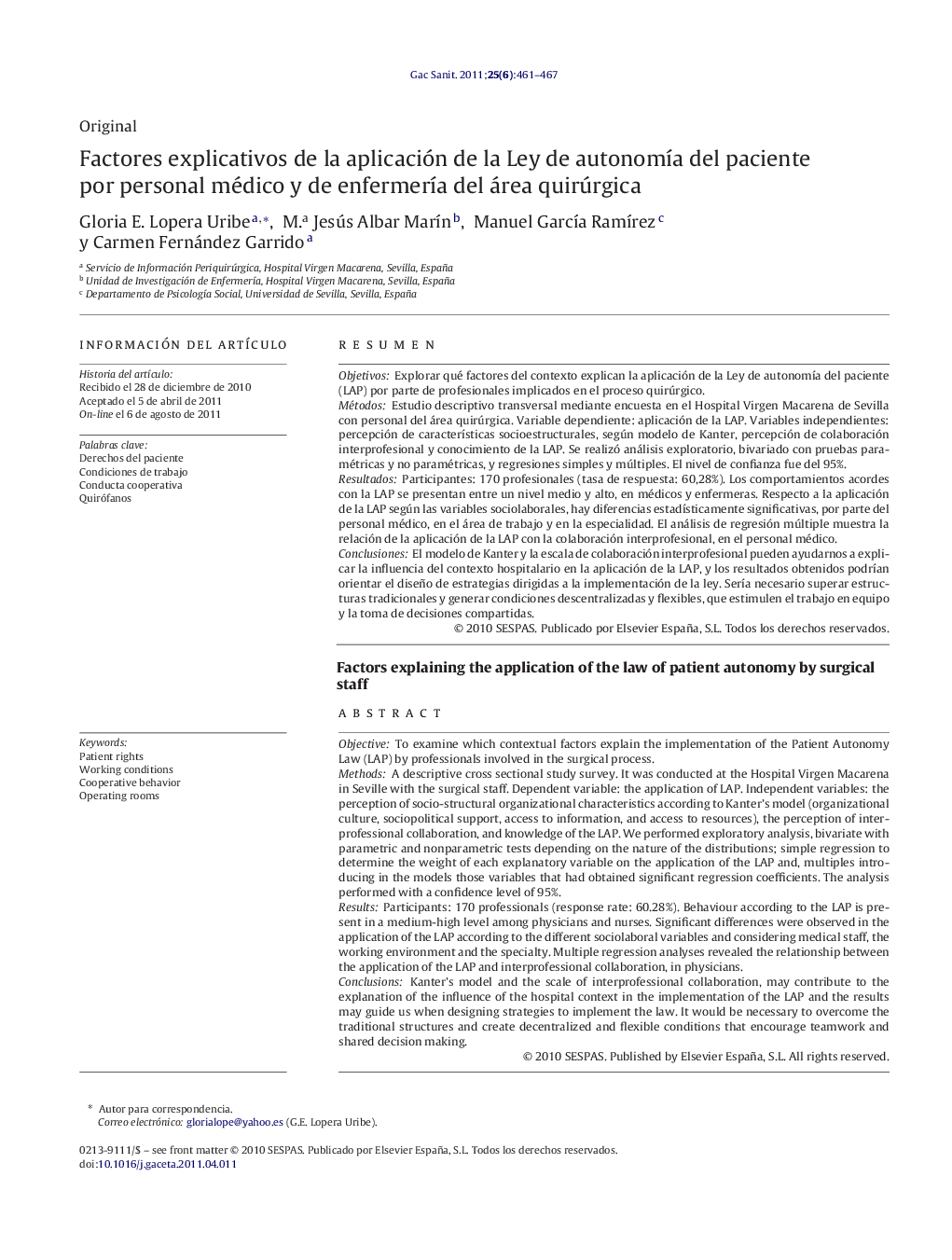| Article ID | Journal | Published Year | Pages | File Type |
|---|---|---|---|---|
| 1074047 | Gaceta Sanitaria | 2011 | 7 Pages |
ResumenObjetivosExplorar qué factores del contexto explican la aplicación de la Ley de autonomía del paciente (LAP) por parte de profesionales implicados en el proceso quirúrgico.MétodosEstudio descriptivo transversal mediante encuesta en el Hospital Virgen Macarena de Sevilla con personal del área quirúrgica. Variable dependiente: aplicación de la LAP. Variables independientes: percepción de características socioestructurales, según modelo de Kanter, percepción de colaboración interprofesional y conocimiento de la LAP. Se realizó análisis exploratorio, bivariado con pruebas paramétricas y no paramétricas, y regresiones simples y múltiples. El nivel de confianza fue del 95%.ResultadosParticipantes: 170 profesionales (tasa de respuesta: 60,28%). Los comportamientos acordes con la LAP se presentan entre un nivel medio y alto, en médicos y enfermeras. Respecto a la aplicación de la LAP según las variables sociolaborales, hay diferencias estadísticamente significativas, por parte del personal médico, en el área de trabajo y en la especialidad. El análisis de regresión múltiple muestra la relación de la aplicación de la LAP con la colaboración interprofesional, en el personal médico.ConclusionesEl modelo de Kanter y la escala de colaboración interprofesional pueden ayudarnos a explicar la influencia del contexto hospitalario en la aplicación de la LAP, y los resultados obtenidos podrían orientar el diseño de estrategias dirigidas a la implementación de la ley. Sería necesario superar estructuras tradicionales y generar condiciones descentralizadas y flexibles, que estimulen el trabajo en equipo y la toma de decisiones compartidas.
ObjectiveTo examine which contextual factors explain the implementation of the Patient Autonomy Law (LAP) by professionals involved in the surgical process.MethodsA descriptive cross sectional study survey. It was conducted at the Hospital Virgen Macarena in Seville with the surgical staff. Dependent variable: the application of LAP. Independent variables: the perception of socio-structural organizational characteristics according to Kanter's model (organizational culture, sociopolitical support, access to information, and access to resources), the perception of interprofessional collaboration, and knowledge of the LAP. We performed exploratory analysis, bivariate with parametric and nonparametric tests depending on the nature of the distributions; simple regression to determine the weight of each explanatory variable on the application of the LAP and, multiples introducing in the models those variables that had obtained significant regression coefficients. The analysis performed with a confidence level of 95%.ResultsParticipants: 170 professionals (response rate: 60.28%). Behaviour according to the LAP is present in a medium-high level among physicians and nurses. Significant differences were observed in the application of the LAP according to the different sociolaboral variables and considering medical staff, the working environment and the specialty. Multiple regression analyses revealed the relationship between the application of the LAP and interprofessional collaboration, in physicians.ConclusionsKanter's model and the scale of interprofessional collaboration, may contribute to the explanation of the influence of the hospital context in the implementation of the LAP and the results may guide us when designing strategies to implement the law. It would be necessary to overcome the traditional structures and create decentralized and flexible conditions that encourage teamwork and shared decision making.
